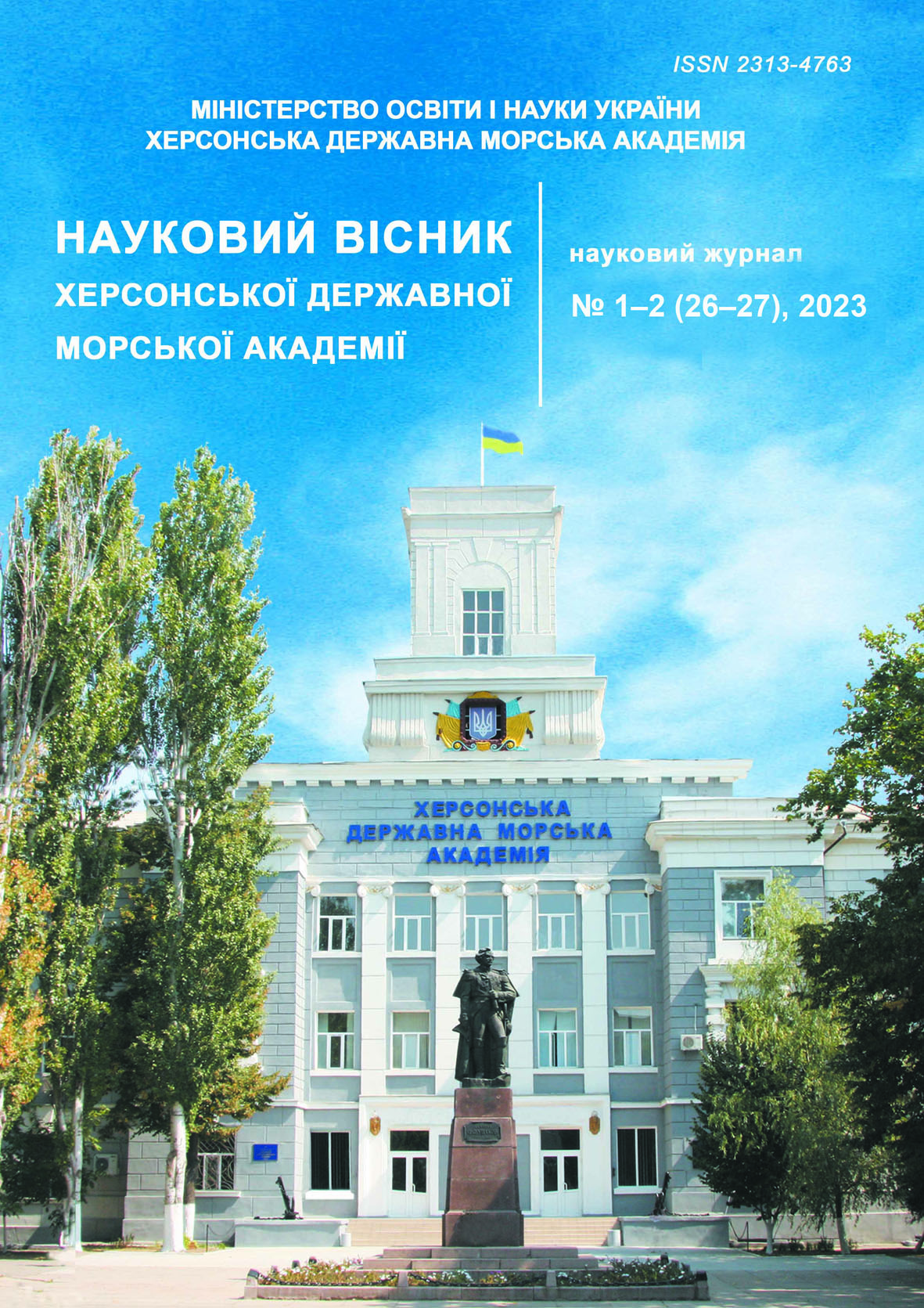INFLUENCE OF THE ELECTRIC SHIPS’ DESIGN PARAMETERS ON THE PERFORMANCE OF THE «ZIGZAG» MANEUVER
https://doi.org/10.33815/2313-4763.2023.1-2.26-27.056-068
Abstract
The purpose of the research is to develop a method for assessing the influence of the design parameters of electric ships’ hull on maneuverability. Methodology. When maneuvering, all components of the propulsion systems operate in transient modes, significantly influencing one another. A comprehensive approach to the construction of a method for estimating maneuvering indices is substantiated. The analysis is based on a mathematical model of transient modes of ship propulsion systems. The main provisions of dynamic similarity theory are used. Results. Criteria of dynamic similarity are found, which significantly affect the maneuver capability indices. A method for assessing the quality indices of the «zigzag» maneuver performance has been developed. A comparative analysis of the effect of the electric ship hull elongation on the main maneuvering quality indices has been carried out. It is shown that with an increase in the length of the vessel up to 10%, the main indices in accordance with the Maneuverability Standards do not deteriorate. The performance of the electric power plant does not exceed the permissible limits. For the purpose of economic feasibility, elongation of the ship's hull within the specified limits is permissible. Scientific novelty. The main provisions used in the construction of the method for assessing the quality indices of the «zigzag» maneuver performance ensure its versatility. The transition to generalized dimensionless parameters makes it possible to cover a large class of vessels by research. Practical significance. The developed method of calculation enables us to evaluate the degree of deviation of electric ships’ maneuvering indices when additional inserts are introduced into the ship's hull. It becomes possible to predict the maneuvering properties of modernized ships. Bibl. 15 tab. 3, fig. 5.
References
Cruise Market Watch: веб-сайт. URL: https://cruisemarketwatch.com/passenger-origins.
Cruise Lines International Association (CLIA). URL: https://www.cruising.org.au.
Det Norske Veritas Holding AS (“DNV Holding”). (2014). Access mode. Electronic resource: www.dnv.com. Alexandros Chiotopoulos, Gerd-Michael Wuersig, Atle Ellefsen. Retrofitting cruise ships to LNG by elongation. LNG as ship fuel the future. Today No 01.
Shumylo, O. (2023). Optymizatsiya rozmirnoyi modernizatsiyi pasazhyrsʹkykh suden z urakhuvannyam enerhoefektyvnosti. Rozvytok transportu.
Saunders, Aaron. (2013). Giants of the Sea : The Ships that Transformed Modern Cruising. Seaforth Publishing.
Rudenko Sergey, Shakhov Anatoliy, Lapkina Inna, Shumylo Oleksandr, Malaksiano Mykola, Horchynskyi Ihor. Multicriteria Approach to Determining the Optimal Composition of Technical Means in the Design of Sea Grain Terminals. https://www.scopus.com/authid/ detail.uri?authorId=57211999743.
Dmytro S Minchev, Oleksiy A Gogorenko, Roman A Varbanets, Yuryi L Moshentsev, Vaclav Pı´sˇteˇk, Pavel Kucˇera, Oleksandr M Shumylo and Vladyslav I Kyrnats. Prediction of centrifugal compressor instabilities for internal combustion engines operating cycle simulation. Journal of Automobile Engineering 1–13 IMechE 2022 Article reuse guidelines : sagepub.com/journals-permissions https://doi.org/10.2478/pomr-2022-0046.
Varbanets Roman, Shumylo Oleksandr, Marchenko Andrey Petrovich, Minchev Dmytro, Kyrnats Vladyslav, Zalozh Vitalii, Aleksandrovska Nadiia, Brusnyk Roman Olehovych, Volovyk Kateryna. (2022). Concept of vibroacoustic diagnostics of the fuel injection and electronic cylinder lubrication systems of marine diesel engines. POLISH MARITIME RESEARCH 4 (116) Vol. 29, Р. 88–96 10.2478/pomr-2022-0046. DOI: 10.1177/09544070221075419 journals.sagepub. com/home/pid https://sciendo.com/article/ 10.2478/pomr-2022-0046.
Pershyts, R. (1983). Upravlyaemostʹ y upravlenye sudom: Monohrafiya. Lenynhrad: Sudostroenye.
Teresa Abramowicz-Gerigk, Miroslaw K. Gerigk. (2020). Experimental study on the selected aspects of bow thruster generated flow field at ship zero-speed conditions. Ocean Engineering, vol. 209 (92): 107463. DOI: 10.1016/j.oceaneng.2020.107463.
Kupraty, O. (2021). Mathematical modelling of construction of ship turning trajectory using autonomous bow thruster work and research of bow thruster control specifics. Scientific Journal of Gdynia Maritime University, No. 118, June. Р. 7–23. DOI: 10.26408/118.01.
Golikov, V. A., Golikov, V. V., Volyanskaya, Y., Mazur, O., Onishchenko, O. (2018). A simple technique for identifying vessel model parameters. IOP Conference Series : Earth and Environmental Science. 172 (1), DOI: http://dx.doi.org/10.1088/1755-1315/172/1/012010.
Yarovenko, V. A. (1999). Rozrakhunok i optymizatsiya perekhodnykh rezhymiv propulʹsyvnykh kompleksiv elektrokhodiv : Monohrafiya. Odesa.
Yarovenko, V. A., Chernykov, P. C. (2017). Metod rozrakhunku perekhodnykh rezhymiv hrebnykh elektroenerhetychnykh ustanovok elektrokhodiv. Elektrotekhnika i elektromekhanika. 32–41. DOI: 10.20998/2074-272X.2017.6.05.
Yarovenko, V. A., Chernykov, P. C., Zarytskaya, E. I., Shumylo, A. N. (2020). Upravlinnya hrebnymy elektrodvyhunamy elektrokhodiv pry rusi po kryvolyneynoy traektoriyi. Elektrotekhnika i elektromekhanika. 58–65. DOI: 10.20998/2074-272X.2020.5.09.






